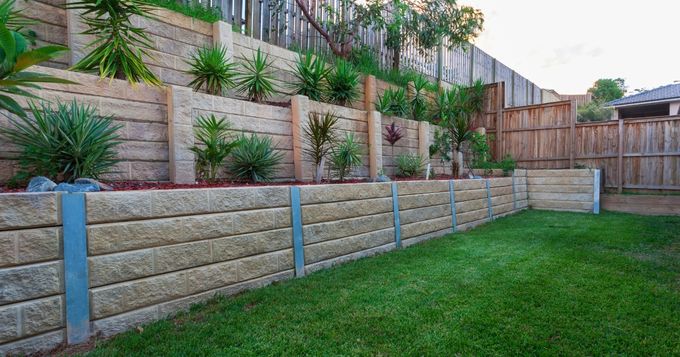
A retaining wall is a structure built to hold back soil on a hillside. It is used to prevent soil erosion, landslides, and to create level spaces for flower beds, home gardens, patios, or other landscaping features.
Some of the common materials used to construct these walls in San Francisco include:
- Pressure treated lumber
- Concrete Masonry Units (CMU)
- Poured Concrete
- Interlocking Concrete Blocks
These materials provide the much needed structural support that holds back the soil and create a wall system. These walls can do more than just hold back soil. It can provide a wide range of benefits that can enhance the functionality and aesthetics of your outdoor space. The functionality, though, depends on the materials used and wall height.
Whether you’re looking to create level areas for gardening, prevent erosion, or home improve the overall look of your property, the decision to add these walls on your slope can help you achieve these goals.
Improved Functionality
These walls can be used to create level spaces on a hillside, making it easier to use and enjoy your outdoor space. For example, if you have a sloping backyard, a retaining wall can be used to create a level area for a patio or garden. This allows you to use your outdoor space more effectively, and makes it much more enjoyable to spend time in. Additionally, these walls can be used to create a level area for a driveway, fixed support, walkway, or other functional outdoor features.
Erosion Control
Retaining walls can help prevent soil erosion by holding back the soil on a hillside and preventing it from slipping or sliding. Hillside properties are particularly susceptible to erosion because of the steep slope and the fact that water and gravity can cause soil to slide downhill.
Retaining walls hold the soil in place thus preventing soil erosion from occurring. This can not only help protect your property, but it can also help protect surrounding properties from erosion as well.
Increased Property Value
A well-built retaining wall can improve the overall look of your property, increasing its value. Setting the blocks with precision on the slope will create a beautiful landscaping feature that will make your property stand out.
A retaining wall can be used to create a functional outdoor space that can be used for entertaining or relaxing. This can make your property more attractive to potential buyers and increase its overall value.
Enhanced Aesthetics
Retaining walls can be designed to be decorative, adding visual interest to your outdoor space. For example, a retaining wall can be built with different types of stone or brick to create a unique and beautiful look.
Also, a retaining wall can be designed to include built-in seating, lighting, or other features that can enhance the overall aesthetic of your outdoor space.
Versatility
Retaining walls can be made from a variety of materials, such as stone, concrete, brick, or wood, and can be designed to match any style of home. Whether you have a traditional home or a modern home, a retaining wall can be designed to complement the overall style of your property.
Different types of materials can be used to create different looks, such as a natural stone wall for a rustic look or a concrete wall for a modern look.
Low Maintenance
Retaining walls are low maintenance once they are built and can last for many years with minimal upkeep. Once a retaining wall is installed, it requires very little maintenance. Most types of retaining walls are built to last for many years, even decades, which means that they can provide benefits for many years to come.
Climate Adaptability
Retaining walls can be built to withstand extreme weather conditions, such as heavy rain, strong winds, and even earthquakes. Retaining walls are designed to be strong and durable, which means that they can withstand a wide range of weather conditions. This means that even if you live in an area that is prone to extreme weather, this wall can still be a great investment.

Frequently Asked Questions about a Retaining Wall on a Hillside
We get hundreds of questions from property owners planning to build a retaining wall on their hillside properties. Here are the five most common questions to give you a better understanding of what a retaining wall prevents.
What materials are commonly used to build a retaining wall on a hillside?
Common materials used for retaining walls on hillsides include: pressure treated wood, natural stone, concrete masonry, and poured concrete. The choice of material will depend on the location, type of soil, and design of the wall.
How do I know if I need a retaining wall on my hillside property?
If you have a steep slope on your property that is causing erosion or making it difficult to use the outdoor space, you may need a retaining wall. Additionally, if you are considering adding a patio, garden, or other outdoor feature to your property, a retaining wall may be necessary to create a level area.
How much does it cost to build a retaining wall on a hillside?
The cost of building a retaining wall on a hillside varies depending on the materials used, the size of the wall, and the location of the property. On average, a retaining wall can cost between $15 and $30 per square foot.
How long does it take to build a retaining wall on a hillside?
The time it takes to build a retaining wall on a hillside will depend on the size and complexity of the wall. A small wall can be built in a few days, while a larger and more complex wall can take several weeks.
Do I need a permit to build a retaining wall on my hillside property?
Many municipalities require a permit to build a retaining wall on a hillside property. It is important to check with your local government to determine if a permit is necessary and to ensure that the wall is built to code.
Additionally, retaining wall blocks are versatile, low-maintenance, and can be designed to withstand extreme weather conditions. With many different materials and designs to choose from, its great investment for any San Francisco homeowner.
Conclusion
In conclusion, retaining walls can provide a wide range of benefits for homeowners with hillside properties. They can be used to create level spaces for gardening, come in handy in prevention erosion, and make your property aesthetically pleasing.
It is important to consult with a professional to ensure that the wall is designed and built to meet your designed landscape design, conform to local codes and regulations. Overall, installing a retaining wall on a hillside will greatly enhance the functionality and aesthetics of your outdoor space, making it a more enjoyable place to spend time with family and friends.



